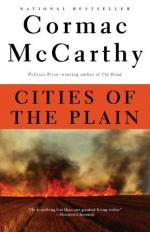|
This section contains 1,291 words (approx. 4 pages at 400 words per page) |

|
Point of View
Cormac McCarthy uses a very restricted, third-person, and omniscient narrative style. The story follows multiple characters and can therefore be considered all knowing, but the narration normally remains detached, never entering the minds of the characters. If a chapter is following Billy it merely follows him, watching him much as a camera might. We do not get the story from Billy's perspective. As a result the narrator is completely dependable because it only describe what happens and does not make any guesses.
We as readers are almost never explicitly told what a character is thinking or feeling. Instead the author describes their actions and gives us their words. From them we can infer emotion.
The only exception to this detachment is Magdalena. She is the one character whose emotions we are told about. For example, when Eduardo confronts her about leaving the White Lake without his...
|
This section contains 1,291 words (approx. 4 pages at 400 words per page) |

|




